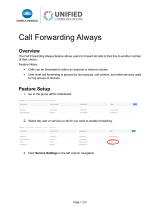
16
Delegation of Incoming Calls for Windows
Call delegation is a feature that enables faculty or staff to
delegate phone calls handling up to one or more administrative
delegates. When a delegate answers a call, Lync notifies the
owner of the account that the call has been answered, along
with the name of the delegate answering.
*This feature is not available for Mac users.
Why would you choose to use this feature?
• Your delegate can screen your calls, transferring the
calls when appropriate.
• Your delegate can create or join a voice conference
on your behalf.
• If you share an Outlook Inbox with a delegate, the
delegate can listen to your voice mail and respond.
You may direct Lync to send your calls to a Delegate immedi-
ately, or after a 5, 10, or 15 second delay.
Forwarding calls to Delegates:
Forwarding your calls to your Delegate(s) allows you to send
incoming calls to someone else. When you click on the For-
ward my calls to option, you can then select to forward your
calls to ‘My Delegates.’
First, you must add Delegate(s). To do so:
1. Click on the Add button. A list of your contacts opens.
2. In the Contact List, select one or more of your
contacts as your Delegate(s). You may only select
persons inside your organization.
3. Click OK.
4. Ensure any of your Delegates that you wish to re-
ceive your forwarded calls have checkmarks in the
boxes next to their names.
Note: To edit this list after you create it the first time, click
on the Edit my delegate members link in the Call Forwarding
environment of the Lync Options window.
Simultaneous Ringing
If you choose the ‘Simultaneous ring’ option, your Lync work
phone will ring as will a second number, designated when
you select this option.
Note: If you choose a long-distance phone number for si-
multaneous calling, the IU phone system will prompt anyone
calling from IU’s system for a long-distance access code.
When this occurs, the call bypasses your Lync work-phone
completely and goes directly to the long-distance number.
Redirecting a Call in Lync
If you have additional numbers listed in your Lync Options,
you can choose from those numbers to redirect calls.
To redirect an incoming call:
1. In the Incoming Call alert, click the Redirect button.
A pop-up list of numbers appears.
2. Click your choice. The redirected call rings on the
selected device or directs to Voice Mail.




















